|
Stavanger
|
Sverd i fjell (Swords in rock)
Three enormous bronze swords stand monument to the battle of Hafrsfjord in the year 872, when Harald Hårfagre (Fairheaded Harald) united Norway into one kingdom. The monument was designed by Fritz Røed (1928 - 2002) from Bryne, just south of Stavanger. It was unveiled by Norway's King Olav in 1983. The swords, which are about 10 meters tall, stand for peace and unification. One sword is larger than the others. This was Fairheaded Harald's sword. The swords are planted in solid rock - representing peace - they will never be used again.
|
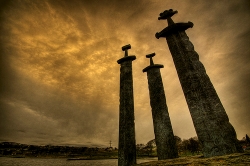
|
|
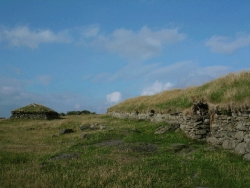
|
The Iron Age Farm
The Iron Age Farm at Ullandhaug is a reconstructed farm complex from the time of the Great Migrations, approximately AD 350-550. The farmstead is located on the top of Ullandhaug, around 3 km from the centre of Stavanger, and has a magnificent view of North-Jæren and the Hafrsfjord. The Iron Age Farm at Ullandhaug, the only one of its kind in Norway, was reconstructed on the tofts of a farmstead from the Migration Period. The three houses are fitted up with equipment and domestic utensils, and a fire is burning on the original hearths.
|
|
Stavanger Cathedral (Stavanger domkirke)
This is Norway’s oldest cathedral. Bishop Reinald, who may have come from Winchester in England, is said to have started construction of the Cathedral around 1100. It was finished around 1125, and the city of Stavanger counts 1125 as its year of foundation. The Cathedral was consecrated to the Holy Trinity, and Saint Swithun was chosen for its patron saint.
Stavanger was ravaged by fire in 1272, and the Cathedral suffered heavy damage. It was rebuilt under bishop Arne, and the Romance Cathedral was enlarged in the Gothic style.
In 1682, king Christian V decided to move Stavanger's episcopal seat to Kristiansand. After this the city suffered a decline that lasted for almost 200 years.
However, on Stavanger's 800th anniversary in 1925, king Haakon VII instated Jacob Christian Petersen as Stavanger's first bishop in nearly 250 years.
|
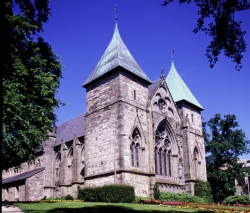
|
|

|
Valbergtårnet (The Tower at Valberget)
This tower is situated on a hill overlooking large parts of the town centre. Its original function was as ‘office’ for watchmen walking aroud town in the 16th and 17th century telling time at night and watching out for fire. As the city centre of Stavanger mostly had buildings of wood this was a very important job. They also kept a look-out from the top floor of the tower. Today you can visit the tower during the day and climb all the stairs to the top where you get a nice view of the harbour and shopping area. The ground floor has a gallery where you can buy knitwear and pottery.
|
|
Gamle Stavanger
Gamle Stavanger, also known as Straen, is the largest surviving wooden house settlement in northern Europe with its 173 listed buildings. The houses were built in the late 1700s and early 1800s and nearly all houses are small and painted white (only a few are allowed to be another colour). Craftsmen, seamen and workers inhabited most of the houses. It was common that several families, often up to 20-25 people, lived together in one house with a living area only 4-5 m² á person. Today the houses are owned partly by private people, partly by the municipality.
Cobbled alleys and houses are telling the story of the lives of the people who lived here before. Gamle Stavanger is one of Stavanger’s most popular tourist attractions and at the moment probably one of the most desirable living area in town. There are a few play areas, some bench seats and several public "pocket parks". This part of town is almost totally uncommercialised, though with a few galleries where you can watch artists at work and buy their handicrafts. In the middle of Gamle Stavanger you also find the canning museum where they once canned millions of smoked sardines and shipped them all over the world.
|
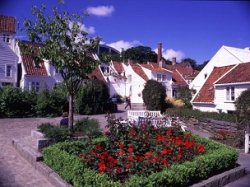
|
|
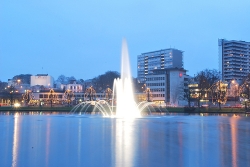
|
Breiavatnet at night
In the middle of town there is a small lake with a beautiful fountain that is lit at night. The railway station and the bus station are on one side of the lake. The cathedral and the cathedral school are on the other side.
|
|
Broken column (sculptures by Anthony Gormley)
23 iron sculptures, all 1.95 meters tall, have been placed in and around Stavanger's City Center. Some have been erected outdoors and some inside shops, schools and even a private home. Every sculpture stands exactly 1,95 meters higher than one of the others, i.e. if they were placed on top of each other they would form a column of 44,85 meters, hence the name ‘Broken column’.
The sculpture to the left is outside the cinema.
The one to the right is placed inside the town courthouse.
|
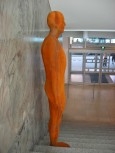
|
|

|
Norsk Oljemuseum (Norwegian Petroleum Museum)
The Norwegian Petroleum Museum was opened on 20 May 1999. The unusual architecture has made the museum a landmark in the Port of Stavanger. Seen from the sea the museum looks like a small oil platform. The museum focuses on offshore petroleum activity especially in the North Sea.
|
|
Solastranden (the beach at Sola)
About one mile south of Stavanger you can find some beautiful sand beaches like this by the airport at Sola. When the weather is warm people from all over the region gather here to bathe and enjoy the sun during weekends and afternoons.
|

|
|

|
Viking stadion (Viking stadium)
This is the stadium of Stavangers top foootball club called Viking. It was opened in 2004 and can seat 16.000 persons. In addition to football matches great concerts are given here. There are pland to expand the stadium. Norway is applying to arrange the European Championship in 2016. The dream of the region is that some of the matches can be played here.
|
|

|